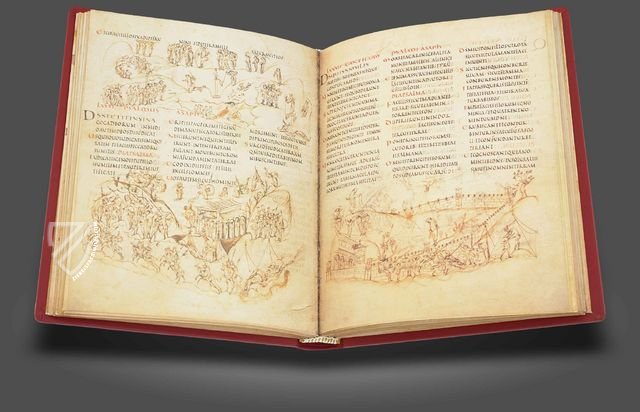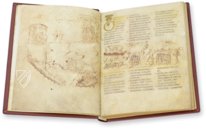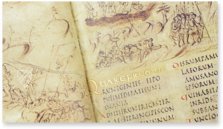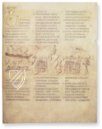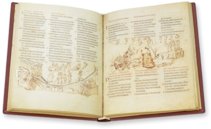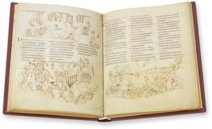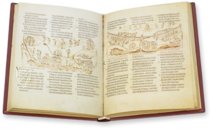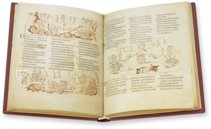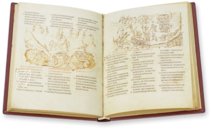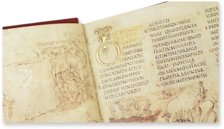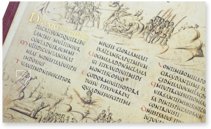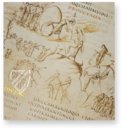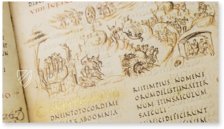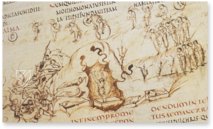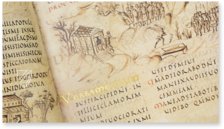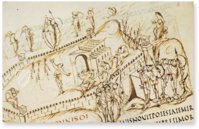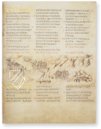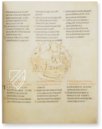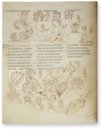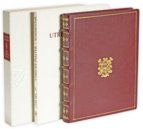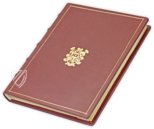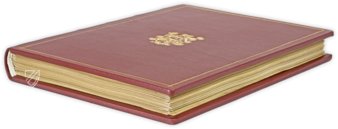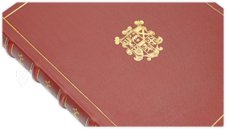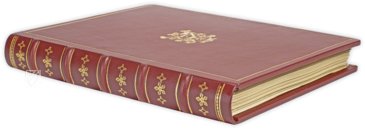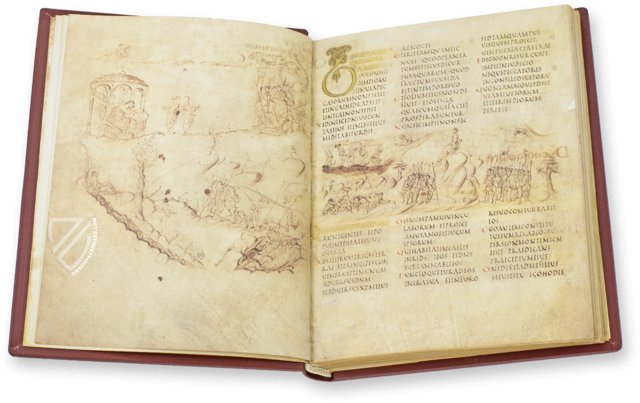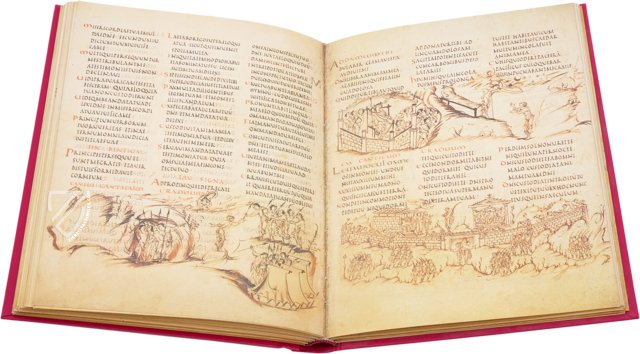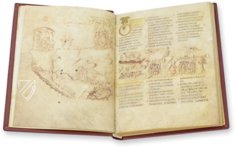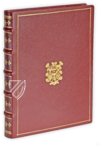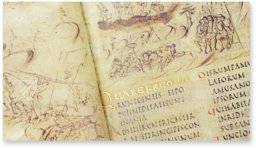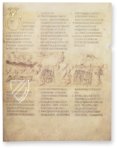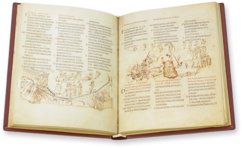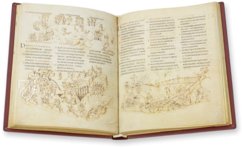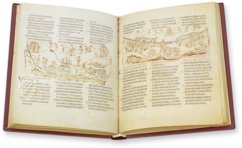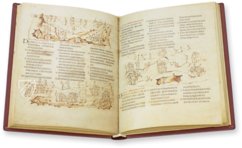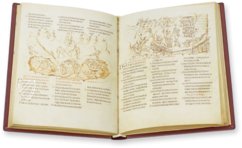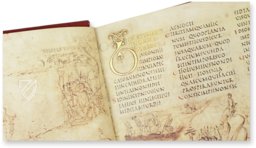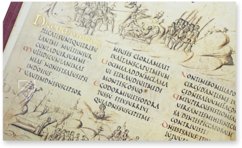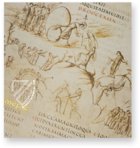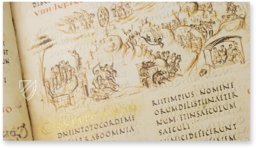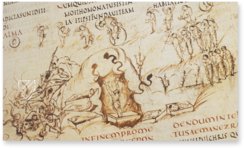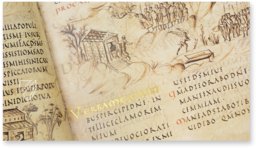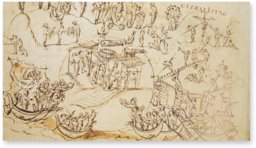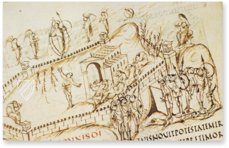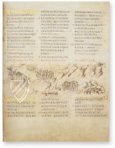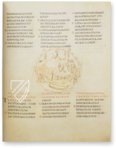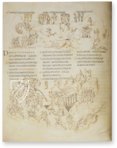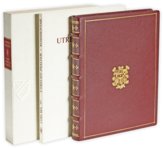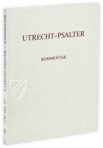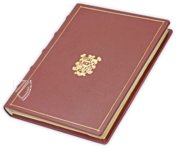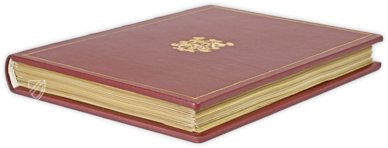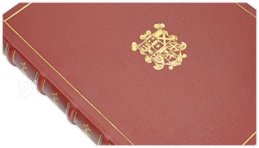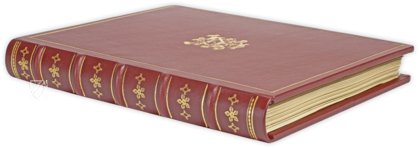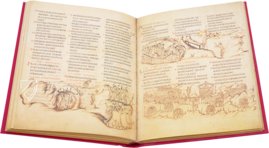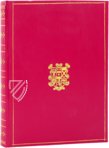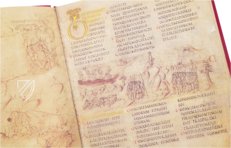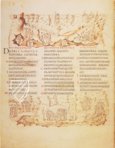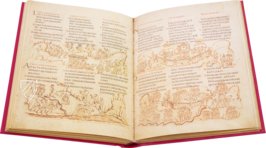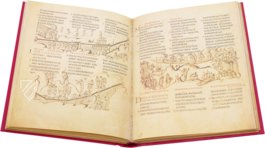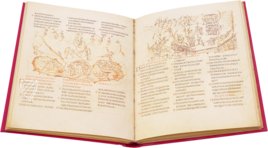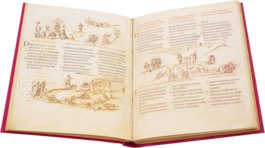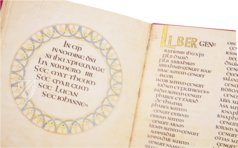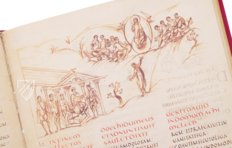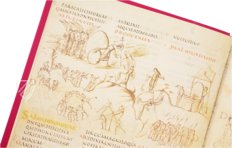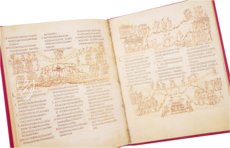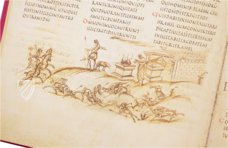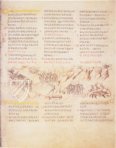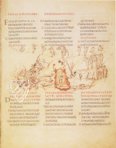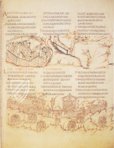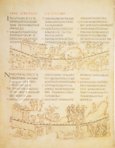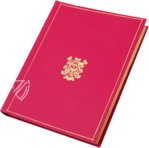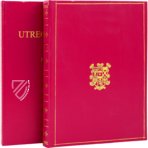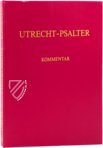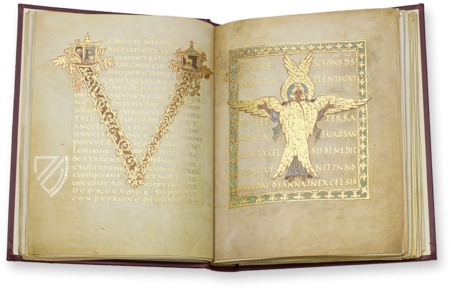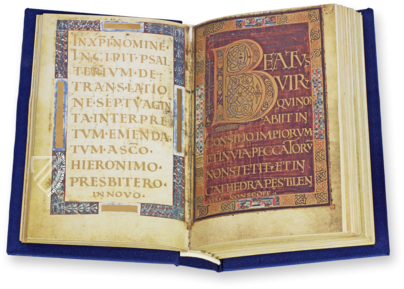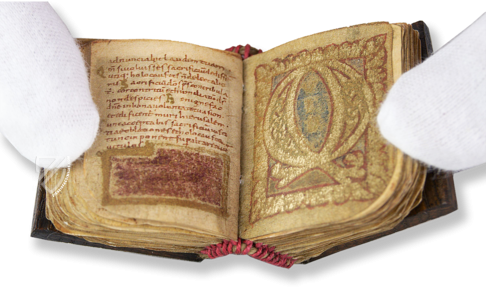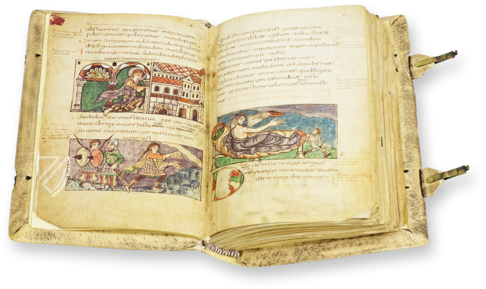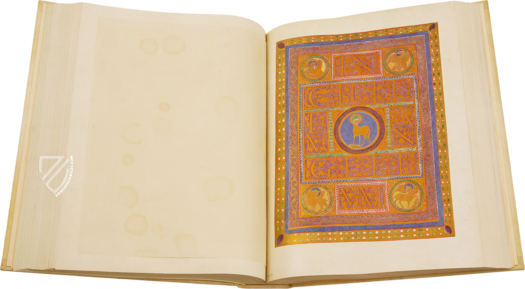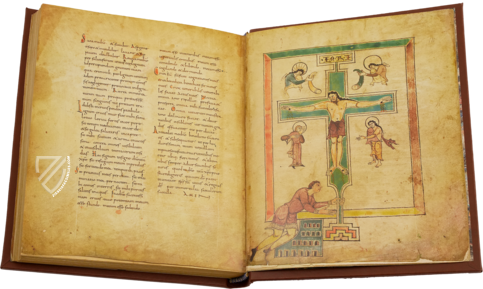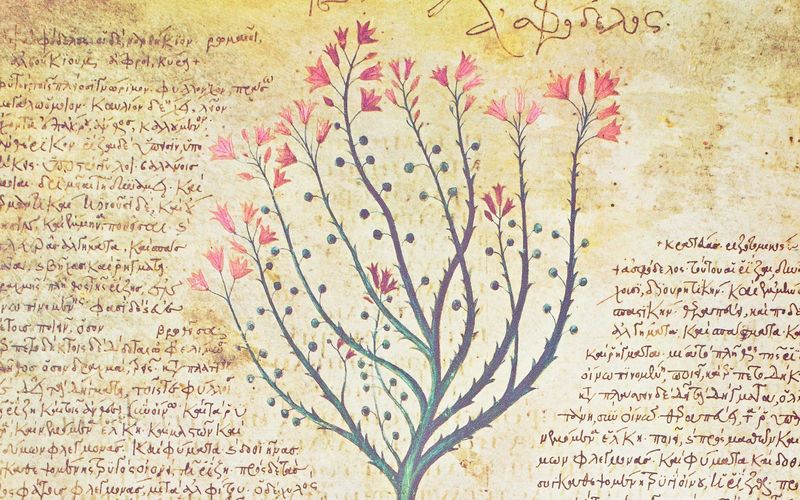Utrecht Psalter
(1,000€ - 3,000€)
With the famous Utrecht Psalter, the so-called “Da Vinci of the 9th century” created one of the most influential works in European art history, which today belongs to the UNESCO World Heritage List for good reason. Art historians have repeatedly compared the anonymous master of this extraordinary Psalter to Leonardo da Vinci, Rembrandt van Rijn or even Vincent Van Gogh: he created this unique masterpiece of Carolingian book illumination between 820 and 840 in the Benedictine abbey of Hautevillers near Reims. The manuscript is also considered to be the oldest surviving illuminated Psalter in Western book history. However, at least as impressive are the 166 dramatic and dynamic pen and ink drawings themselves, which continuously accompany the 150 psalms. The various figures are depicted both very expressively and no less sensitively. With their liveliness, they gave a long-lasting impulse to European art even before the turn of the millennium.
The Utrecht Psalter
The psalter as a basic work of monastic choral song steadily gained in importance from the 6th century onward. The Utrecht Psalter is one of the finest manuscripts of this period and probably the most unusual psalter of the Middle Ages. It was written out and painted between 820 and 840 in the Benedictine abbey of Hautvillers near Rheims, on the initiative of Ebbo, archbishop of Rheims and a foster brother of Emperor Louis the Pious. This sumptuous illuminated work of the Carolingian period is the earliest surviving example of an illustrated Psalter in Western book production.
166 Lively and Exciting Miniatures
All 150 Psalms are illustrated with magnificent pen drawings covering the whole width of a page and densely populated with tiny figures hurriedly sketched with a few strokes. These vigorously painted figures are frequently imbedded in faintly sketched landscapes and display a vibrant liveliness. In accordance with the beauty of the text, they are executed in unprecedented perfection. The creative power of the artist has led many renowned art historians to place the master of these pages on equal footing with the great artists of the western world, like Leonardo da Vinci, Rembrandt or Vincent van Gogh. In addition to the extraordinary expressive power of the drawings, one must be impressed with the artist’s continuous effort to follow the text as closely as possible and marvel at the sheer wealth of symbolism in his illustrations.
A Century-Old Model
The Utrecht Psalter has influenced the evolution of European art throughout the ages, not only in the field of illumination but also in other areas of Carolingian art. It was, above all, the expressive nature and at the same time refined character of the drawings which enriched European art before the first millennium with fresh and spirited elements. Around the year 1000, the manuscript was brought to England. After the dissolution of English monasteries, the codex passed into private hands. In the 16th century, the Psalter entered the possession of Sir Robert Cotton who had the book bound in the present day full binding of red leather.
Codicology
- Alternative Titles
- Utrecht-Psalter
- Size / Format
- 222 pages / 33.0 × 25.6 cm
- Origin
- France
- Date
- Between 820 and 840
- Epochs
- Style
- Genre
- Language
- Script
- Rustic capitals
- Illustrations
- 166 fantastic miniatures from the Carolinian royal court school
- Content
- 150 psalms and biblical hymn texts
- Patron
- Ebbo, archbishop of Rheims
- Artist / School
- Reims school
- Previous Owners
- Sir Robert Cotton
Utrecht Psalter
Start of Psalm 81
The 81st Psalm is often referred to as “An Appeal for Israel’s Repentance” but is also centered on the theme of celebration. As such, the Israelites are shown blowing horns on the hillside and worshipping in the temple as angels hover overhead. “Sing aloud to God our strength; Make a joyful shout to the God of Jacob. Raise a song and strike the timbrel, The pleasant harp with the lute. Blow the trumpet at the time of the New Moon, At the full moon, on our solemn feast day.” (Ps. 81:1-3)
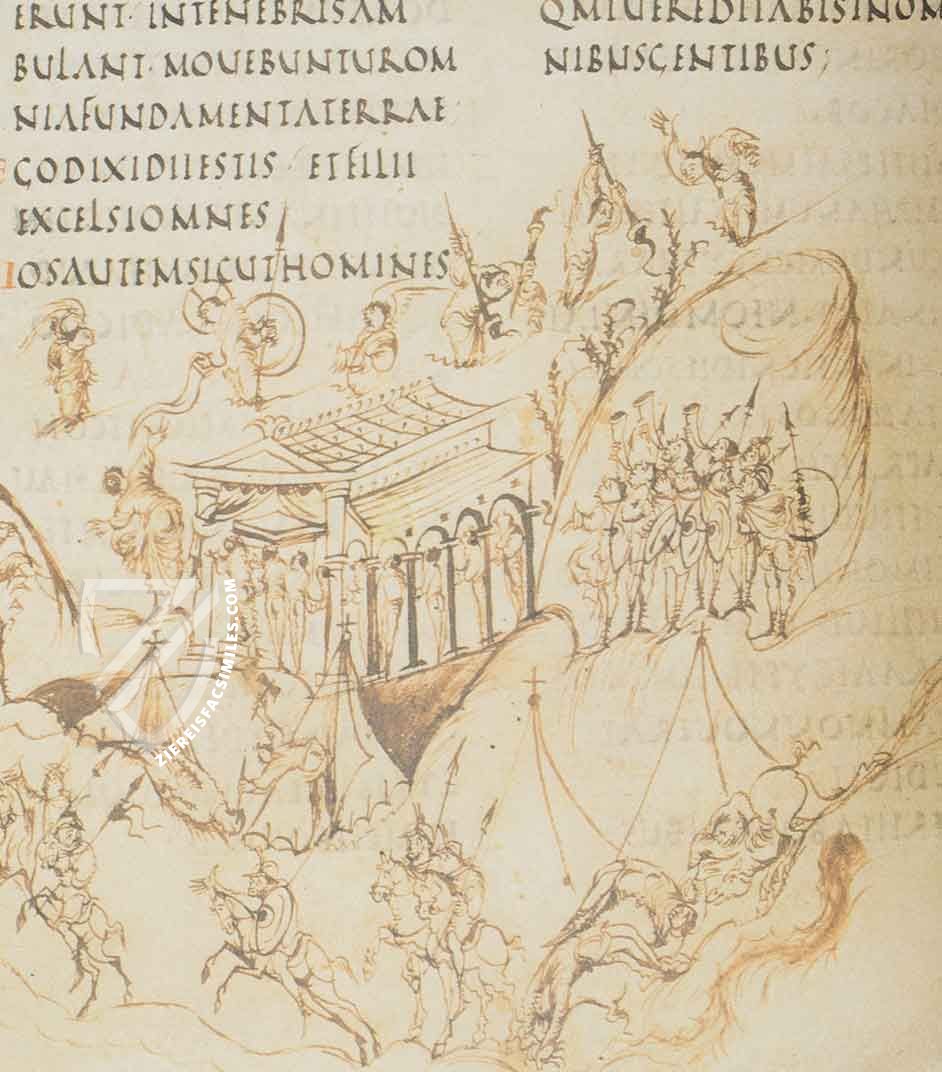
Utrecht Psalter
Psalm 2
This masterful grisaille miniature directly illustrates the text in which it is embedded. The only color is in the Insular-style initials with gold leaf, red, and green, as well as the small red initials in the text. This is a prophetic verse, portraying Christ standing on Mt. Zion and identified by a hand to the right giving the sign of benediction: “The Lord hath said to me: Thou art my son, this day I have begotten thee” (Ps. 2:7).
The hosts assembled around Mt. Zion are Gentiles who have raged and devised vain things, inducing God’s rage, depicted above them with his arm extended outward. Christ appears to break a pot, referencing Ps. 2:9: “Thou shat rule them with a rod of iron, and shalt break them in pieces like a potter’s vessel”.
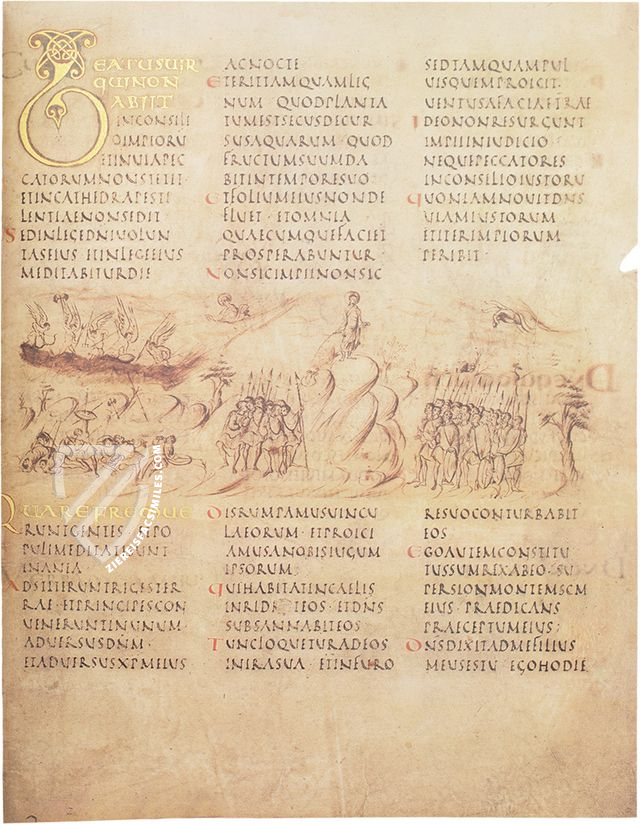
#1 Der Utrecht-Psalter (Luxury Edition)
Language: German
The commentary volume includes 116 pages and introduces the reader to the world of the Carolingian Renaissance while also providing a comprehensive explanation of the manuscript’s lavish decoration.
K. van der Horst, Utrecht, revised by J. Rathofer, Cologne. 116 pp., 33 black-and-white illustrations.
(1,000€ - 3,000€)
#2 Der Utrecht-Psalter (Faux-Leather Edition)
Language: German
(1,000€ - 3,000€)
- Treatises / Secular Books
- Apocalypses / Beatus
- Astronomy / Astrology
- Bestiaries
- Bibles / Gospels
- Chronicles / History / Law
- Geography / Maps
- Saints' Lives
- Islam / Oriental
- Judaism / Hebrew
- Single Leaf Collections
- Leonardo da Vinci
- Literature / Poetry
- Liturgical Manuscripts
- Medicine / Botany / Alchemy
- Music
- Mythology / Prophecies
- Psalters
- Other Religious Books
- Games / Hunting
- Private Devotion Books
- Other Genres
- Afghanistan
- Armenia
- Austria
- Belgium
- Belize
- Bosnia and Herzegovina
- China
- Colombia
- Costa Rica
- Croatia
- Cyprus
- Czech Republic
- Denmark
- Egypt
- El Salvador
- Ethiopia
- France
- Germany
- Greece
- Guatemala
- Honduras
- Hungary
- India
- Iran
- Iraq
- Israel
- Italy
- Japan
- Jordan
- Kazakhstan
- Kyrgyzstan
- Lebanon
- Liechtenstein
- Luxembourg
- Mexico
- Morocco
- Netherlands
- Palestine
- Panama
- Peru
- Poland
- Portugal
- Romania
- Russia
- Serbia
- Spain
- Sri Lanka
- Sweden
- Switzerland
- Syria
- Tajikistan
- Turkey
- Turkmenistan
- Ukraine
- United Kingdom
- United States
- Uzbekistan
- Vatican City
- A. Oosthoek, van Holkema & Warendorf
- Aboca Museum
- Ajuntament de Valencia
- Akademie Verlag
- Akademische Druck- u. Verlagsanstalt (ADEVA)
- Aldo Ausilio Editore - Bottega d’Erasmo
- Alecto Historical Editions
- Alkuin Verlag
- Almqvist & Wiksell
- Amilcare Pizzi
- Andreas & Andreas Verlagsbuchhandlung
- Archa 90
- Archiv Verlag
- Archivi Edizioni
- Arnold Verlag
- ARS
- Ars Magna
- ArtCodex
- AyN Ediciones
- Azimuth Editions
- Badenia Verlag
- Bärenreiter-Verlag
- Belser Verlag
- Belser Verlag / WK Wertkontor
- Benziger Verlag
- Bernardinum Wydawnictwo
- BiblioGemma
- Biblioteca Apostolica Vaticana (Vaticanstadt, Vaticanstadt)
- Bibliotheca Palatina Faksimile Verlag
- Bibliotheca Rara
- Boydell & Brewer
- Bramante Edizioni
- Bredius Genootschap
- Brepols Publishers
- British Library
- C. Weckesser
- Caixa Catalunya
- Canesi
- CAPSA, Ars Scriptoria
- Caratzas Brothers, Publishers
- Carus Verlag
- Casamassima Libri
- Centrum Cartographie Verlag GmbH
- Chavane Verlag
- Christian Brandstätter Verlag
- Circulo Cientifico
- Club Bibliófilo Versol
- Club du Livre
- CM Editores
- Collegium Graphicum
- Collezione Apocrifa Da Vinci
- Comissão Nacional para as Comemorações dos Descobrimentos Portugueses
- Coron Verlag
- Corvina
- CTHS
- D. S. Brewer
- Damon
- De Agostini/UTET
- De Nederlandsche Boekhandel
- De Schutter
- Deuschle & Stemmle
- Deutscher Verlag für Kunstwissenschaft
- DIAMM
- Droz
- E. Schreiber Graphische Kunstanstalten
- Ediciones Boreal
- Ediciones Grial
- Ediclube
- Edições Inapa
- Edilan
- Editalia
- Edition Deuschle
- Edition Georg Popp
- Edition Leipzig
- Edition Libri Illustri
- Editiones Reales Sitios S. L.
- Éditions de l'Oiseau Lyre
- Editions Medicina Rara
- Editorial Casariego
- Editorial Mintzoa
- Editrice Antenore
- Editrice Velar
- Edizioni Edison
- Egeria, S.L.
- Eikon Editores
- Electa
- Emery Walker Limited
- Enciclopèdia Catalana
- Eos-Verlag
- Ephesus Publishing
- Ernst Battenberg
- Eugrammia Press
- Extraordinary Editions
- Fackelverlag
- Facsimila Art & Edition
- Facsimile Editions Ltd.
- Facsimilia Art & Edition Ebert KG
- Faksimile Verlag
- Feuermann Verlag
- Folger Shakespeare Library
- Franco Cosimo Panini Editore
- Friedrich Wittig Verlag
- Fundación Hullera Vasco-Leonesa
- G. Braziller
- Gabriele Mazzotta Editore
- Gebr. Mann Verlag
- Gesellschaft für graphische Industrie
- Getty Research Institute
- Giovanni Domenico de Rossi
- Giunti Editore
- Graffiti
- Grafica European Center of Fine Arts
- Guido Pressler
- Guillermo Blazquez
- Gustav Kiepenheuer
- H. N. Abrams
- Harrassowitz
- Harvard University Press
- Helikon
- Hendrickson Publishers
- Henning Oppermann
- Herder Verlag
- Hes & De Graaf Publishers
- Hoepli
- Holbein-Verlag
- Houghton Library
- Hugo Schmidt Verlag
- Idion Verlag
- Il Bulino, edizioni d'arte
- ILte
- Imago
- Insel Verlag
- Insel-Verlag Anton Kippenberger
- Instituto de Estudios Altoaragoneses
- Instituto Nacional de Antropología e Historia
- Introligatornia Budnik Jerzy
- Istituto dell'Enciclopedia Italiana - Treccani
- Istituto Ellenico di Studi Bizantini e Postbizantini
- Istituto Geografico De Agostini
- Istituto Poligrafico e Zecca dello Stato
- Italarte Art Establishments
- Jan Thorbecke Verlag
- Johnson Reprint Corporation
- Josef Stocker
- Josef Stocker-Schmid
- Jugoslavija
- Karl W. Hiersemann
- Kasper Straube
- Kaydeda Ediciones
- Kindler Verlag / Coron Verlag
- Kodansha International Ltd.
- Konrad Kölbl Verlag
- Kurt Wolff Verlag
- La Liberia dello Stato
- La Linea Editrice
- La Meta Editore
- Lambert Schneider
- Landeskreditbank Baden-Württemberg
- Leo S. Olschki
- Les Incunables
- Liber Artis
- Library of Congress
- Libreria Musicale Italiana
- Lichtdruck
- Lito Immagine Editore
- Lumen Artis
- Lund Humphries
- M. Moleiro Editor
- Maison des Sciences de l'homme et de la société de Poitiers
- Manuscriptum
- Martinus Nijhoff
- Maruzen-Yushodo Co. Ltd.
- MASA
- Massada Publishers
- McGraw-Hill
- Metropolitan Museum of Art
- Militos
- Millennium Liber
- Müller & Schindler
- Nahar - Stavit
- Nahar and Steimatzky
- National Library of Wales
- Neri Pozza
- Nova Charta
- Oceanum Verlag
- Odeon
- Orbis Mediaevalis
- Orbis Pictus
- Österreichische Staatsdruckerei
- Oxford University Press
- Pageant Books
- Parzellers Buchverlag
- Patrimonio Ediciones
- Pattloch Verlag
- PIAF
- Pieper Verlag
- Plon-Nourrit et cie
- Poligrafiche Bolis
- Presses Universitaires de Strasbourg
- Prestel Verlag
- Princeton University Press
- Prisma Verlag
- Priuli & Verlucca, editori
- Pro Sport Verlag
- Propyläen Verlag
- Pytheas Books
- Quaternio Verlag Luzern
- Reales Sitios
- Recht-Verlag
- Reichert Verlag
- Reichsdruckerei
- Reprint Verlag
- Riehn & Reusch
- Roberto Vattori Editore
- Rosenkilde and Bagger
- Roxburghe Club
- Salerno Editrice
- Saltellus Press
- Sandoz
- Sarajevo Svjetlost
- Schöck ArtPrint Kft.
- Schulsinger Brothers
- Scolar Press
- Scrinium
- Scripta Maneant
- Scriptorium
- Shazar
- Siloé, arte y bibliofilia
- SISMEL - Edizioni del Galluzzo
- Sociedad Mexicana de Antropología
- Société des Bibliophiles & Iconophiles de Belgique
- Soncin Publishing
- Sorli Ediciones
- Stainer and Bell
- Studer
- Styria Verlag
- Sumptibus Pragopress
- Szegedi Tudomànyegyetem
- Taberna Libraria
- Tarshish Books
- Taschen
- Tempus Libri
- Testimonio Compañía Editorial
- Thames and Hudson
- The Clear Vue Publishing Partnership Limited
- The Facsimile Codex
- The Folio Society
- The Marquess of Normanby
- The Richard III and Yorkist History Trust
- Tip.Le.Co
- TouchArt
- TREC Publishing House
- TRI Publishing Co.
- Trident Editore
- Tuliba Collection
- Typis Regiae Officinae Polygraphicae
- Union Verlag Berlin
- Universidad de Granada
- University of California Press
- University of Chicago Press
- Urs Graf
- Vallecchi
- Van Wijnen
- VCH, Acta Humaniora
- VDI Verlag
- VEB Deutscher Verlag für Musik
- Verlag Anton Pustet / Andreas Verlag
- Verlag Bibliophile Drucke Josef Stocker
- Verlag der Münchner Drucke
- Verlag für Regionalgeschichte
- Verlag Styria
- Vicent Garcia Editores
- W. Turnowski Ltd.
- W. Turnowsky
- Waanders Printers
- Wiener Mechitharisten-Congregation (Wien, Österreich)
- Wissenschaftliche Buchgesellschaft
- Wissenschaftliche Verlagsgesellschaft
- Wydawnictwo Dolnoslaskie
- Xuntanza Editorial
- Zakład Narodowy
- Zollikofer AG

